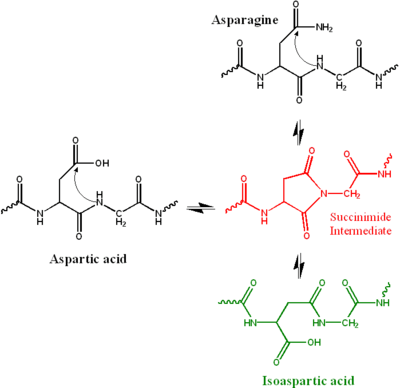Isoaspartate

The isoaspartate group is a functional group in biochemistry.[1][2] Its formation is a chemical reaction in which the side chain of an asparagine or aspartic acid residue attacks the following peptide group (in black at top right of Figure 1), forming a symmetric succinimide intermediate (in red). The symmetry of the intermediate results in two products of its hydrolysis, either aspartate (in black at left) or in iso(Asp), which is a β-amino acid (in green at bottom right). The reaction also results in the deamidation of the asparagine residue.
Kinetics of isoaspartyl formation
Isoaspartyl formation reactions have been conjectured to be one of the factors that limit the useful lifetime of proteins.
Isoaspartyl formation proceeds much more quickly if the asparagine is followed by a small, flexible residue (such as Gly) that leaves the peptide group open for attack. These reactions also proceed much more quickly at elevated pH (>10) and temperatures.
References
- ↑ Clarke S. (1987) "Propensity for spontaneous succinimide formation from aspartyl and asparaginyl residues in cellular proteins", Int. J., Peptide Protein Res., 30, 808-821.
- ↑ Stephenson RC and Clarke S. (1989) "Succinimide Formation from Aspartyl and Asparaginyl Peptides as a Model for the Spontaneous Degradation of Proteins", J. Biol. Chem., 264, 6164-6170.